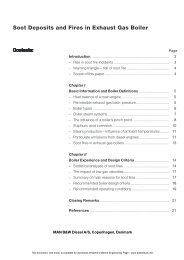Fire on Board the Liberian Passenger Ship Ecstasy, Miami, Florida ...
Fire on Board the Liberian Passenger Ship Ecstasy, Miami, Florida ...
Fire on Board the Liberian Passenger Ship Ecstasy, Miami, Florida ...
- No tags were found...
Create successful ePaper yourself
Turn your PDF publications into a flip-book with our unique Google optimized e-Paper software.
Analysis 61 Marine Accident Reportshould revise <strong>the</strong> SMS to include processes for preventing unauthorized flame cutting,grinding, or o<strong>the</strong>r activities that might ignite a fire.Adequacy Of <str<strong>on</strong>g>Fire</str<strong>on</strong>g> Protecti<strong>on</strong> SystemsSprinkler SystemSprinkler systems are designed to provide an appropriate level of protecti<strong>on</strong> for <strong>the</strong>space that <strong>the</strong>y occupy and <strong>the</strong> amount of combustibles that are present. On <strong>the</strong> <strong>Ecstasy</strong>, apassenger cruise ship, sprinklers were installed mainly in accommodati<strong>on</strong> areas, includingstaterooms and cabins. The sprinkler system, <strong>the</strong>refore, was designed for spaces thatc<strong>on</strong>tained furniture, carpeting, paneling, and so forth.In <strong>the</strong> <strong>Ecstasy</strong> accident, however, c<strong>on</strong>diti<strong>on</strong>s occurred that put unusual demands <strong>on</strong><strong>the</strong> sprinkler system. In <strong>the</strong> main laundry <strong>on</strong> deck No. 2, <strong>the</strong> fire’s area of origin, <strong>the</strong>igniti<strong>on</strong> of <strong>the</strong> comparatively small amount of lint across <strong>the</strong> floor released insufficien<strong>the</strong>at to trigger <strong>the</strong> heat-activated sprinklers in <strong>the</strong> overhead. The small flames spread firstto <strong>the</strong> mangle’s vertical exhaust ducts and <strong>the</strong>n its overhead exhaust ducts where <strong>the</strong> highlint buildup fueled a larger fire. The mangle’s overhead exhaust duct, c<strong>on</strong>structed ofn<strong>on</strong>combustible metal, c<strong>on</strong>tained <strong>the</strong> fire, and <strong>the</strong> air flow within <strong>the</strong> duct carried <strong>the</strong> firefrom <strong>the</strong> laundry to <strong>the</strong> exhaust plenum <strong>on</strong> <strong>the</strong> mooring deck. The fire exited <strong>on</strong>to <strong>the</strong>mooring deck, which lacked fire protecti<strong>on</strong>, and ignited <strong>the</strong> lint debris that, in turn, led to<strong>the</strong> development of <strong>the</strong> major c<strong>on</strong>flagrati<strong>on</strong>.Before <strong>the</strong> ventilati<strong>on</strong> system in MVZs 1 and 2 was shut down, ventilati<strong>on</strong> fansdrew intense heat from <strong>the</strong> large fire <strong>on</strong> <strong>the</strong> mooring deck to various ship areas that wereprotected by sprinklers, which caused <strong>the</strong>m to activate. In additi<strong>on</strong>, <strong>the</strong> heat from <strong>the</strong>mooring deck fire was so great that it triggered sprinklers in deck areas immediately aboveand forward of <strong>the</strong> mooring deck. Although <strong>the</strong> sprinkler discharge in areas that wereremote from <strong>the</strong> mooring stati<strong>on</strong> had no effect <strong>on</strong> <strong>the</strong> fire and heat source, <strong>the</strong> dischargesprevented <strong>the</strong> spread of fire fur<strong>the</strong>r into <strong>the</strong> vessel.The discharge area, that is, <strong>the</strong> number of sprinklers discharging water, was twiceas great as <strong>the</strong> design capabilities of <strong>the</strong> ship’s water delivery system. Even though <strong>the</strong>number of sprinklers that opened created a demand for water that taxed <strong>the</strong> water supply,<strong>the</strong> sprinkler system provided proper protecti<strong>on</strong> in this accident. The Safety <strong>Board</strong>c<strong>on</strong>cludes that <strong>the</strong> vessel’s automatic sprinkler system limited <strong>the</strong> spread of fire from <strong>the</strong>mooring stati<strong>on</strong> to adjoining decks, <strong>the</strong>reby preventing a significantly worse fire thatwould have caused greater damage and perhaps additi<strong>on</strong>al injuries.When <strong>the</strong> <strong>Ecstasy</strong> was built in 1991, Carnival Cruise Lines had until 2006 tocomply with SOLAS requirements for automatic sprinklers. Never<strong>the</strong>less, <strong>the</strong> companyelected to install sprinkler protecti<strong>on</strong> in <strong>the</strong> <strong>Ecstasy</strong>’s cabins and staterooms at <strong>the</strong> time ofc<strong>on</strong>structi<strong>on</strong>. After <strong>the</strong> fire <strong>on</strong> board <strong>the</strong> <strong>Ecstasy</strong>, Carnival Cruise Lines modified <strong>the</strong> firesuppressi<strong>on</strong> system of <strong>the</strong> MV Paradise, <strong>on</strong>e of its ships under c<strong>on</strong>structi<strong>on</strong>, to include
















